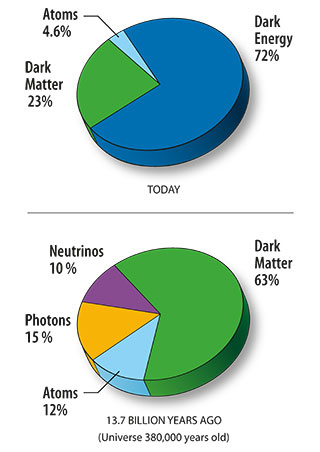
|
|

|

|
|

|
NASA Press Release for Press Conference Today: Probably has to do with Arsenic and how biology may work differently in different places. In Mono Lake (CA) there apparently are organisms which use arsenic as their energy currency for intracellular energy transfer (sort of paraphrased from Wikipedia) rather than phosphorous (as done in ATP (adenosine triphosphate) as in most other organisms on Earth) (see leaked information). If this is indeed the case, this would suggest that life developed in different ways on the Earth indicating that the development of life may be something that occurs whenever it is given an opportunity (again, perhaps in some self-organizing mechanism). This would be neat.
The Universe Contains Many More Stars than Thought Previously
Astronomy 123 is an introduction to the science of astronomy for non-science majors, with an emphasis on the Universe outside of our galaxy and cosmology. The past 10 years has seen an explosion in our understanding of the contents, formation and evolution of the Universe. Changes in our understanding of fundamental physics, combined with discoveries from space and ground-based telescopes, have led to a radically different model of our place in the Universe and its origins. The field of cosmology is science's newest endeavor into the most basic questions of humankind's existence; where do we come from and what is our fate? Cosmology is the meeting point of observational astronomy, philosophy and particle physics. However, unlike philosophy, cosmology engages Nature providing a foundation based in observation and experience.
The specific goals of this class are 1) to gain an understanding of basic science that underlies Astronomy (the forum is modern cosmology), 2) to understand the properties of the objects that make up our Universe, 3) to formulate a coherent philosophy for interpreting the observational evidence of the hot Big Bang and relating this world-view to new areas of research. In addition, this course traces the history of cosmology in order to explore how the scientific method works and how civilization has gained from the progress of science and technology. The interplay between technology (telescopes, space observatories) and knowledge gained about the Universe is a key theme to the course.
Other Astronomy courses in the group:
Astr 121: The Solar System
Astr 122: The Birth and Death of Stars
Instructor: James N. Imamura
Office: 444 Willamette Hall
E-mail: imamura@uoregon.edu
Phone: 541-346-5212
Office Hours: MF, 10:30-noon, TuTh 10:30-noon, or by appointment
Course: ASTR 123: Cosmology |
 |
Total Points Possible = 75+75+75+60+125 = 410 points
Week |
|
|
|
|
|
1,2 |
Introduction |
Chapters 23-27 | 09/28,09/30,10/5 | Topic 1 |
HW 1--due: 5 October 2010 |
2,3 |
The Milky Way Galaxy |
Chapter 23 | 10/7,10/12 | Topic 2 |
HW 2--due: 12 October 2010 |
4 |
Normal Galaxies |
Chapters 24, 25 | 10/19,10/21 | Topic 3 |
HW 3--due: 26 October 2010 |
5 |
Active Galactic Nuclei |
Chapters 24, 25 | 10/26,10/28 |
Topic 4 |
HW 4--due: 2 November 2010 |
5,6 |
World Views of the Universe |
Chapter 26 | 10/28,11/2 |
Topic 5 |
... |
7,8 |
History of the Universe |
Chapters 26, 27 | 11/9,11/11,11/16 |
Topic 6 |
HW 5--due: 16 November 2010 |
8,9 |
The Ultimate Fate of the Universe |
Chapters 24, 25, 26 | 11/18,11/30 |
Topic 7 |
... |
9,10 |
Drake Equation, Fermi Paradox, and SETI |
Chapter 28 |
11/30,12/2 | Topic 8 |
HW 6--due: 2 December 2010 |